As much of the world rallies behind Ukrainians defending their country against a Russian invasion, mainstream news outlets and social media in the United States and elsewhere have been awash in tales of Ukrainian heroism. The Ukrainian defense against a much larger force has indeed been inspiring, but all conflicts include informational warfare—from all sides. Some of the most widely shared images and stories of Ukrainian resistance have fallen apart under scrutiny or in the face of subsequent reporting, yet many who are rightly skeptical of Russian claims are displaying very little caution about pronouncements from the other side, leading to a wave of credulous media coverage that serves to propagandize more than illuminate.
In the opening days of the invasion, no story was more prominent than that of the Ukrainian soldiers giving their lives to defend a small island in the Black Sea from a Russian warship. When asked over the radio to disarm and surrender, the soldiers responded with “Russian warship, go fuck yourself”—their supposedly final act of defiance before the ship opened fire and killed all the soldiers on Snake Island. Audio of the confrontation, shared by Ukrainian officials, received almost universal and laudatory coverage in Western media and became a viral sensation online. If the made-for-TV moment seemed almost too good to be true, that’s because it partly was. Just days after the soldiers were “posthumously” honored, Ukrainian officials revealed that the group was still alive and in Russian custody—just as the Russian defense ministry had said all along.
The heroic last stand on Snake Island is far from the only misinformation or propaganda to be passed around uncritically. A widely shared video of the so-called “Ghost of Kyiv” shooting down Russian fighter jets turned out to be from a combat simulator video game, and fact-checkers have not been able to confirm whether the “Ghost of Kyiv” even exists. A member of the European Parliament, citing dubious “intel from a Ukrainian officer,” claimed Russian President Vladimir Putin has been fuming about the war in a mountain “lair” like that of a James Bond villain, a fantastical tale that has nevertheless been shared tens of thousands of times on Twitter and repeated in outlets like the New York Post. And many viral images and videos showing the horrors of Russia’s attack are in fact repurposed from other conflicts.
Popular
"swipe left below to view more authors"Swipe →
In framing the war in Ukraine, much of the media has found its main protagonist in President Volodymyr Zelensky, the 44-year-old comedian turned statesman now leading his country’s defense from the besieged capital. Zelensky is indeed a compelling figure, but the media coverage has occasionally bordered on hero worship.
When Zelensky refused a US offer to be evacuated from Kyiv, he reportedly responded, “I need ammunition, not a ride.” That remark has been republished in hundreds of news outlets, and became an instant meme on social media. But the source of the quote is a three-paragraph Associated Press story that only cites an anonymous “senior American intelligence official,” as well as official Ukrainian government accounts on social media that helped spread it further. As a piece of political messaging, it’s ingenious—but is it news, or propaganda?
None of this is to suggest Ukrainian sources are uniquely untrustworthy. After all, the biggest lie in this conflict has been Putin’s claim that he was not preparing an invasion. Russian officials have also maintained—despite clear evidence to the contrary—that their military is not hitting civilian targets in Ukraine, and the state-backed broadcaster RT is still calling the invasion a “special operation” while downplaying the scale of the attack. But after years of warnings about the dangers of misinformation, many Western journalists, public figures, and news consumers are failing to apply their skepticism evenly.
Much of the coverage of the Ukrainian crisis has also been remarkably free of controversy regarding potentially millions of refugees fleeing to safety in other countries, the right of civilians to engage in armed resistance, or the ethics of economic and cultural boycotts against states violating human rights and international law. The dispassionate presentation of Ukrainians making Molotov cocktails to fight off an occupying army stands in sharp contrast to how wars in other parts of the world are covered—a fact not lost on many journalists of color.
This double standard is all the more apparent in how prominent journalists have discussed the war. CBS reporter Charlie D’Agata apologized after describing Ukraine as “civilized” compared to places like Iraq or Afghanistan, but he is far from alone. Others have similarly expressed shock that a war could happen outside a “third world nation” to people who “seem so like us.” In response to such examples, the Arab and Middle Eastern Journalists Association released a statement condemning “orientalist and racist” rhetoric and demanded that newsrooms apply the same consideration to all victims of war.
As the Russian offensive drags on, getting the most accurate picture of the situation on the ground is essential, especially with the threat of a nuclear confrontation hanging over the entire conflict. Credulous reporting and unchallenged assumptions about who is and isn’t trustworthy—or who does and doesn’t deserve our compassion—can have major consequences when the stakes are this high.


